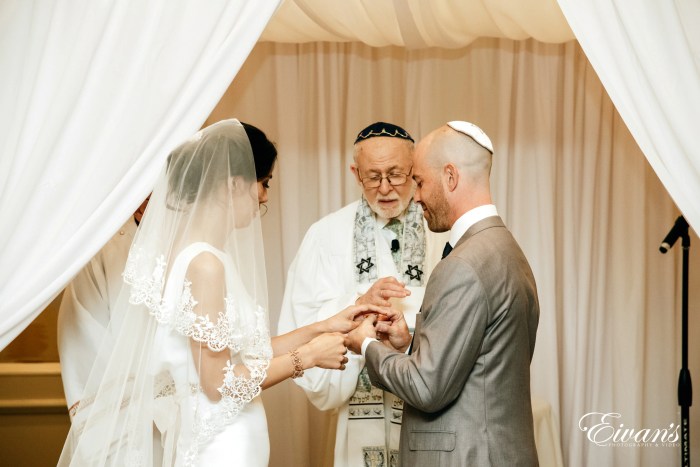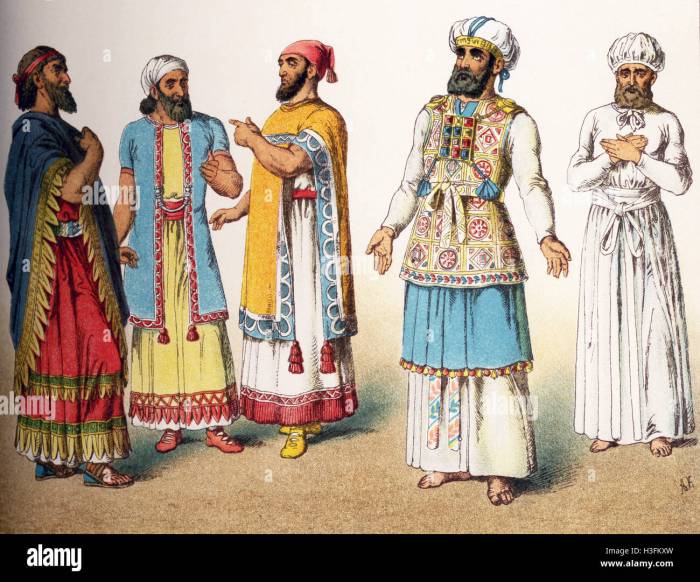Historical Context of Ancient Jewish Wedding Attire
Ancient jewish wedding dress – Understanding the evolution of ancient Jewish wedding attire requires examining various historical periods and geographical locations. The styles and materials used reflected not only the prevailing cultural norms but also the economic status of the individuals involved. This section will trace the development of these garments, highlighting key influences and providing examples.
Evolution of Jewish Wedding Attire Across Different Historical Periods
Biblical accounts offer limited descriptions of wedding attire, suggesting garments reflecting everyday clothing styles, possibly enhanced with finer fabrics or adornments for special occasions. The Roman period saw increasing influence from Roman fashion, with potential incorporation of Roman styles into Jewish garments. The medieval period witnessed regional variations, influenced by local customs and the availability of materials. These variations continued through the centuries.
Influence of Geographical Location and Cultural Exchange
Geographical location significantly impacted the materials and styles of ancient Jewish wedding attire. Communities in warmer climates might favor lighter fabrics like linen, while those in colder regions might use wool or other heavier materials. Cultural exchange with neighboring societies also influenced clothing styles, leading to the adoption or adaptation of certain elements.
Materials Commonly Used in Ancient Jewish Wedding Garments

Source: eivans.com
Ancient Jewish wedding dresses, often simple yet elegant, varied greatly across regions and time periods. The focus was typically on modesty and signifying the transition to married life, rather than elaborate ornamentation. If you’re looking to donate a wedding dress and help someone create their own special day, consider donating to wish upon a wedding donate dress ; it’s a wonderful way to give back.
The spirit of generosity echoes the enduring values of many ancient Jewish wedding traditions.
Common materials included linen, wool, silk (particularly in later periods), and various dyed fabrics. Embroidery, beading, and other forms of embellishment were used to enhance the garments, particularly for wealthier individuals. The availability and cost of these materials would have varied depending on the region and the time period.
Attire of Different Social Classes During the Roman Period
| Period | Social Class | Garment Description | Materials Used |
|---|---|---|---|
| Roman Period (1st-4th Century CE) | Upper Class | Elaborate robes, possibly with intricate embroidery and fine jewelry. Likely included a veil or head covering. | Silk, fine linen, wool, gold jewelry, precious stones |
| Roman Period (1st-4th Century CE) | Middle Class | Simpler robes, possibly with less elaborate embellishments. Linen or wool garments with modest jewelry. | Linen, wool, simple metal jewelry |
| Roman Period (1st-4th Century CE) | Lower Class | Simple, functional garments made from readily available materials. Minimal or no jewelry. | Linen, coarse wool |
| Roman Period (1st-4th Century CE) | Priest’s Wife | Likely more elaborate than middle class, possibly with specific colors or symbols representing her status. | Fine linen, possibly with embroidered details. |
Symbolic Meanings and Rituals
Certain garments and adornments held symbolic significance in ancient Jewish weddings. This section will explore these meanings and the associated rituals.
Symbolic Significance of Garments and Adornments
The veil, for instance, often symbolized modesty, purity, and the transition from maidenhood to marriage. Jewelry might represent prosperity, fertility, or divine protection. Specific colors or patterns could also have held symbolic meanings, although detailed information is limited.
Role of Veils and Head Coverings
Veils and head coverings were common elements of bridal attire, symbolizing modesty and marking the bride’s new status. The specific style and material of the head covering might have varied depending on the region and social class.
Rituals Involving Wedding Attire
While specific details are scarce, it is likely that the donning of the wedding attire was part of a ritualistic process, possibly involving family members or religious leaders. The act of dressing the bride could have been symbolic of her transition into marriage.
Visual Representation of a Bride’s Attire, Ancient jewish wedding dress
Imagine a bride adorned in a flowing linen robe, dyed a rich shade of deep blue, signifying royalty and the heavens. The robe is intricately embroidered with floral motifs symbolizing fertility and abundance. A delicate veil of fine linen, edged with silver thread, gracefully falls from her head, partially obscuring her face, representing modesty and purity. Simple gold earrings and a necklace with a small pendant, perhaps a pomegranate, symbolizing fertility, complete her attire.
The overall impression is one of elegance and reverence, reflecting the solemnity of the occasion.
Comparison with Contemporary Jewish Wedding Attire: Ancient Jewish Wedding Dress

Source: alamy.com
Comparing ancient and modern Jewish wedding attire reveals both continuities and significant changes. While certain symbolic elements persist, modern attire reflects contemporary fashion and cultural influences.
Continuities and Changes in Attire
- Continuity: The concept of a veil or head covering, although styles have dramatically changed.
- Continuity: The emphasis on celebratory attire, though the specific garments and materials differ greatly.
- Change: The shift from primarily linen and wool to a wider range of fabrics, including silk, lace, and other modern materials.
- Change: The integration of contemporary fashion trends into modern Jewish wedding attire.
- Change: The increased diversity in styles reflecting the varied cultural backgrounds of contemporary Jewish communities.
Artistic Depictions and Archaeological Evidence
While written sources are limited, artistic depictions and archaeological findings provide valuable insights into ancient Jewish wedding attire.
Artistic Depictions of Wedding Attire
Mosaics and frescoes from the Roman period sometimes depict women in what might be interpreted as wedding attire, although definitive identification is challenging. These depictions often show women in elaborate robes, sometimes with jewelry and head coverings. The style and details vary depending on the specific artwork.
Archaeological Findings Related to Wedding Garments
Archaeological discoveries of textile fragments and jewelry from ancient Jewish settlements can offer clues about the materials and styles used in wedding attire. The context of the discovery, along with analysis of the artifacts themselves, can help researchers piece together a more complete picture.
Summary of Archaeological Evidence
| Location | Date | Artifact Type | Description |
|---|---|---|---|
| Masada, Israel | 1st Century CE | Textile Fragments | Fragments of linen and wool fabrics, suggesting the use of these materials in clothing. |
| Caesarea Maritima, Israel | Roman Period | Jewelry | Various pieces of jewelry, including earrings and necklaces, potentially worn by brides. |
| Various Sites | Various Periods | Textile Fragments | Additional fragments of varying materials and weaving techniques provide insights into textile production and use. |
Regional Variations in Ancient Jewish Wedding Dress
Ancient Jewish communities across the Roman Empire exhibited regional variations in their wedding attire, reflecting local customs and available resources.
Regional Variations in Attire
The variations were influenced by factors such as climate, access to resources, and interactions with neighboring cultures. Detailed information is limited, but we can speculate based on general patterns of clothing styles in different regions.
- Judea: Likely incorporated elements of both local and Roman styles, using materials like linen and wool, potentially with embellishments depending on social class.
- Galilee: Might have shown more influence from local, non-Jewish traditions, possibly using different dyeing techniques or incorporating unique decorative elements.
- Diaspora Communities: Attire in these communities would have been heavily influenced by the surrounding cultures, leading to significant variations across different regions of the Roman Empire.
Q&A
What specific colors were commonly associated with ancient Jewish wedding dresses?
While definitive evidence is scarce, colors likely varied based on region and period, but white and ivory, symbolizing purity, may have been common in some periods and locations.
Were there any specific hairstyles associated with ancient Jewish brides?
Artistic depictions and archaeological findings suggest a variety of hairstyles, likely influenced by regional customs and prevailing fashion trends. Elaborate braids and intricate updos were possibly common among wealthier brides.
What role did jewelry play in ancient Jewish weddings?
Jewelry likely played a significant role, reflecting both social status and symbolic meaning. Necklaces, earrings, and bracelets, made from various materials, may have been used to adorn the bride.
